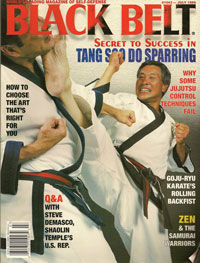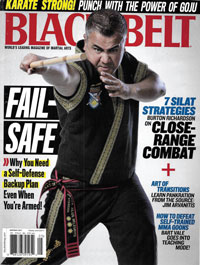Technical Helps
Picture Help Sequences

Armlock with Finger Grip – Ude Guruma Yubi Waza
This armlock is ideal to use on a larger person or if you have small hands. It’s an excellent alternative to the wrist press armlock & is now used by a number of major law-enforcement agencies. Once set you have a great deal of control over the person & it can be quite painful – so use caution!
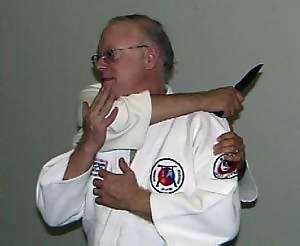
Initial Response for Knife at Throat, Attacker Behind You
A knife at your throat from behind is a serious threat to your life [understatement]. If the person wants your possessions [money, jewelry, car, etc …] give it to the assailant. They can all be replaced. YOU CAN’T! However, here are some initial responses that can be used to get the knife away from your throat if you have to defend yourself. You must immediately continue on with a follow-through technique to remove yourself from imminent danger.

Te Nage [Hand Throw] or Mae Heji Maki [Forward Elbow Roll Takedown]
For a rear forearm choke attack and a knife coming up at your throat. Who thought of this attack? Charles Choi wanted my input on what to do for such an attack.
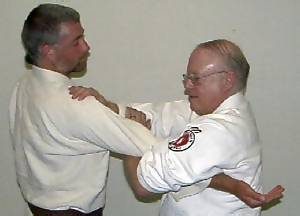
Ude Guruma Makikomi – Figure-4 Armbar Winding Throw Setup
Setting up an attacker for a Figure-4 armbar can be achieved 100% of the time if you follow these simple setup steps – even against a taller attacker.

Ude Guruma Otoshi [Shoulder-lock Drop Throw] [3/03]
This is a defense for a knife in your back, with your back arched. Practice this defense slowly to achieve smoothness. It is an extremely fast technique once proficiency is achieved because your constantly working in a circle. Be careful though. You can’t complete this technique without posing the risk of serious injury to your workout partner.
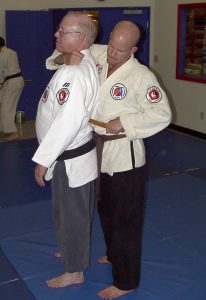
Tekubi Maki – Wristlock Takedown & Press [3/03]
This is a defense for a knife in your back & a forearm choke with your back straight. This is a more difficult situation than having your back arched as you don’t have any “wiggle room.” Be sure to check my footwork as you learn this technique. Footwork is always critical.
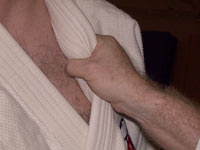
Don’t Break Your Thumb in Randori or Grappling [5/04]
When you grab a gi in randori/grappling it is common to see competitors grab their opponent’s gi with a grip where their thumb grabs the gi from underneath [or opposite their fingers & palm] like when you normally grab something.

Two Simple Fixes for the Hand Throw [Te Nage] & Wristlock Takedown [Tekubi Shimi Waza] [1/05] YouTube video [5/11]
One common mistake made by newer students is to place both thumbs next to each other when setting up the hand throw [te nage] or wristlock takedown [tekubi shimi waza]. The problem with this placement is that the tori is pushing down at two points, rather than one. A second common mistake in setting up either the hand throw or wristlock takedown – shown here – is placing all your fingers of both hands on the inside of the uke’s wrist.

Thumb Press Technique [Ube Shioku Waza] [1/05] <
YouTube video [5/11]
In this counter for a hand shake, students will commonly press against the tip of the thumb & then try to lift the thumb away.
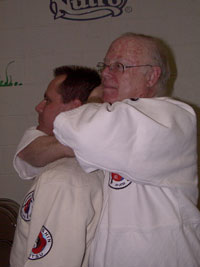
Carotid Artery Press [Figure-4 Neck Nerve Press] Fix [3/05]
The Carotid Artery Press can be an extremely effective means of putting your opponent out — quickly. Unfortunately it also poses a high risk of serious injury or death if not applied properly throughout execution of the hold.
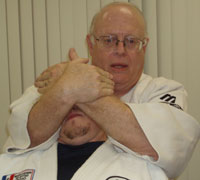
Cross-Cheek Press Takedown [3/07]
The Cross-Cheek Press Takedown is an effective alternative to the Carotid Artery Press [above].

Nose-Bridge Takedown [3/07]
This takedown is another safe alternative to the figure-4 carotid neck restraint. In addition to pressing down on the bridge of the nose, it also eliminates the person’s vision until they are down; a fairly disorienting asset.

Tai-Otoshi Fixes [2/09]
YouTube video [12/10]
Some people are having problems properly setting their footwork for a Tai-Otoshi. The is a tendency to place their right foot as much as 1-2 feet behind the right foot of the uke, blocking the leg just below the knee joint rather than at his ankle. As a result the right leg locks at the knee joint, thus making the throw very difficult to execute & placing a high risk of injury to both tori and uke. This series shows the correct foot placement for the tori’s right & left feet.

Nozo No Ushiro Nage [2/09]
In some Ju-Jitsu ryu this is a secret technique taught only to black belts. In Budoshin Ju-Jitsu, and other ryu, it’s taught to white belts because of its simplicity and ease of helping students learn the concept of self-control and control of their attackers. it can be a very gentle technique which will only cause a gag response by the attacker. It can also be a fatal technique if the “victim” is in fear for their life. So this technique should be used with a great deal of caution.
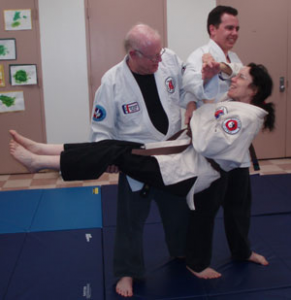
Uki Otoshi [3/09]
Uki Otoshi is one of the most difficult techniques to learn in jujitsu, requiring almost a “leap of faith” for lack of a better term. In the 1970’s three of my junior high brown belts came up with a quick way to help students learn this difficult throw. Students using this method usually had the throw down after 4-5 repeats of this “supported” approach.

Little Finger Figure-4 Brace 7/12
This series of pix presents a clearer view of this technique originally presented on pp. 171-175 of my book, Jujitsu Figure-4 Locks.
YouTube Fixes

Countering a Sucker-Punch – YouTube video 4/12
This is a short narrated video taken at Black Belt Publications on how to effectively counter a sucker-punch, assuming you know it’s coming.

Basic Hip Throw [Koshin Nage] Fixes – YouTube video 5/12
This short [1 minute 40 second] video shows a lot of common errors in executing a basic hip throw [koshi nage] and how to execute such a throw properly.

Hip Throw & Drop Throw Body Placement – YouTube video 2/13
Lot’s of people have problems with setting up hip throws and drop throws [and their variations] because they think they have to enter the throw differently based upon the attacker’s leg positions. This video shows how your body placement solves this problem quite easily and simply. It’s not what you do but how you do it.

Kubi Shioku Waza NOT a Submission Hold – YouTube video 9/13
Many practitioners use this Side Neck Nerve Attack technique as a standing submission when in fact it’s a very quick and painless “sleeper” technique. Check this YouTube video out on how to apply this hold correctly, but be careful when applying pressure.

Counter for Kicks to Your Side on the Ground – YouTube video 2/14
Getting kicked on the ground is extremely dangerous. Here’s a technique you can use against such an attack. Practice the technique slowly as doing it full speed can result in extremity fractures and/or a concussion to the attacker.

Figure-4 Leg Lock for Rear Body or Rear Waist Grab – YouTube video 5/14
The FIgure-4 Leg Lock is an effective submission on the street. It should be PRACTICED SLOWLY in the dojo to avoid setting the hold too fast, which could dislocate and/or separate your uke’s kneecap. Check out this YouTube video. This is a relatively fast lock to set once you get it down. Maintaining your balance is key to protecting your uke from injury.

C-Grip – YouTube video 5/17
The C-Grip is a simple grip which will allow you to set many holds without letting your opponent know what you’re doing until the hold is set. This 5-minute video by George Kirby shows the proper way to set up and use the C-grip to transition to other techniques. Click on the title to go to the YouTube video.

Headlock Escape into a Shoulderlock Takedown – YouTube video 2012. Reposted 2/19. This video, originally produced by blackbeltmag.com, is still on YouTube. So I reposted this video with the YouTube link.

Ura Harai – YouTube video 2/19
This short video, taken at Sensei Rick Rorres’s dojo in Texas, shows a reasonable ura harai [rear sweeping hip throw, executed by two of his students. This was originally posted on YouTube in 2013.

Self-Defense Foot Stomp for Grab from Behind – YouTube video 2/19
Originally posted by blackbeltmag.com in 2011 this video shows Sensei Mark Jordan demonstrating a significant variation of a foot stomp, striking downward on the inside of the ankle. Note: alljujitsu.com is offline.

Defense Against a Grab & Punch – YouTube video 2/19
In this video Sensei Mark Jordan demonstrates one response to a lapel grab and punch, ultimately going into a forward shoulderlock takedown. Originally posted by Mark Jordan in 2008. Note: alljujitsu.com is offline.

Training Tips, Techniques, and Variations — YouTube video 2/20
This instructional video by Sensei George Cushinan, contains a variety of Budoshin Jujitsu training tips, techniques and variations presented by Sensei George Cushinan, one of my top and very resourceful black belts. All movements are shown slowly with emphasis on closeups and foot/body position. It’s always a pleasure to see what George has come up with – very interesting and effective variations at times. Length: 59 minutes!!

Side Wristlock [Hyperextension] Takedown — YouTube video 5/20
This short [1:25 minute] video shows how to properly set up one kind of side wristlock takedown. Note the placement of my left thumb & index finger in the execution of this lock/takedown. Execute this technique very slowly as it’s easy to break the wrist even if done at a normal speed.

LED Flashlight: Empty Hand Applications — YouTube video 5/20
This video covers what to ideally look for in a small LED flashlight you might want to use as a self-defense weapon. The video also presents some “empty hand” applications for a small LED flashlight, originally presented at the 2018 Budoshin Jujitsu Summer Camp in Santa Clarita, CA. This video is about 17:28 minutes long.

Ju-Shin Excerpt/Example — YouTube video 5/20
This is an excerpt briefly describing and showing a Ju-Shin sequence from the Budoshin Jujitsu 2015 Summer Camp. Ju-Shin [Gentle Spirit], is a simple exercise similar to Tai-Chi.
If you need to practice traditional jujitsu or aikido techniques on your own, combining them into a logical sequence, this video should help you get a start.

Elbow Roll Takedown Fix – YouTube video 10/20
This video is an excerpt from the October 3, 2020, Zoom workshop. It deals with a common mistake in setting up and executing an Elbow Roll Takedown. The fixes shown will make effective execution a lot easier and give you more control options. Thanks to Sensei Darryn Melerine, Minami Ryu Jujitsu, for providing the dojo environment and uke for this fix.
Magazine Articles
To open up a pdf version of any of the articles below, most written by George Kirby, just click on the title of the article. Newer articles will eventually be posted here as well.
Thanks to Black Belt for making these articles available to you online. To subscribe to Black Belt magazine please click here.

“How to Do a Demonstration”
Self-Defense World, Jan., 1976
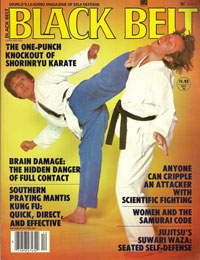
“JuJitsu Suwari Waza“
Black Belt, Dec., 1980
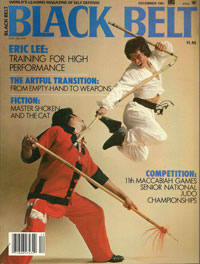
“Transition from Empty-Hand to Weapons”
Black Belt, Dec., 1981
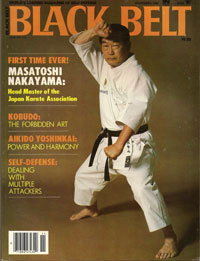
“Dealing with Multiple Attackers”
Black Belt, Dec., 1982
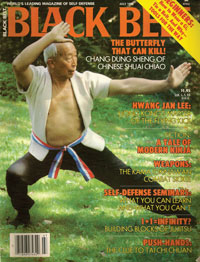
“Building Blocks of Jujitsu, Part 1”
Black Belt, July, 1983

“Building Blocks of Jujitsu, Part 2”
Black Belt, Aug., 1983
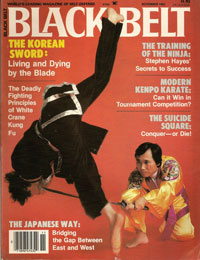
“A Message from the Pond” [editorial]
Black Belt, Nov., 1983
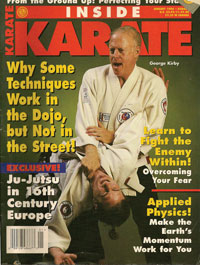
“Dojo Vs Street”
Inside Karate, Jan., 1996
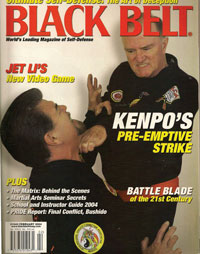
“Pride or Necessity” [editorial]
Black Belt, Feb., 2004
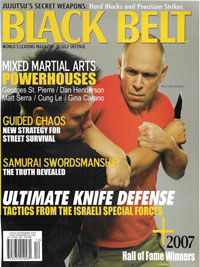
“Block & Strike — Jujitsu’s Secret Weapon”
Black Belt, Dec., 2007

“Instructor of the Year”
Black Belt, Dec., 2007

“5 Lifesaver Jujitsu Escape Techniques”
Black Belt, Sept., 2011
Zoom Workshops

Budoshin Jujitsu: Zoom Workshop Aug. 1, 2020: Episode 1: Technique Fixes –YouTube video
This is the first of a series of Zoom videos dealing with various elements of traditional jujitsu techniques. This workshop is an open-ended seminar covering a variety of topics. So the workshop went in whatever direction the participants guided it. Length: 1:07:20.

Budoshin Jujitsu: Zoom Workshop Sept. 5, 2020: Episode 2: Kuzushi Maneuver – YouYube video
In this workshop we presented options on dealing with bigger attackers, the role of osoto gari, and an introduction to Ju-Shin [updating and ancient exercise]. Length: 0:25

Budoshin Jujitsu: Zoom Workshop Oct. 3, 2020: Episode 3: The Search for Taisho – YouTube video
This workshop dealt with issues pertaining to kicking defenses [blocks, deflections & tactics], multiple attacker strategies and tactics, the value of techniques transitioning skills, and effective ways to execute and elbow roll.. . Length: 1:11:39.

Budoshin Jujitsu: Zoom Workshop Oct. 17, 2020: Episode 4: Shuhari – YouTube video
The three topics for this workshop were 1] the Covid-19 impact on your dojo & how you’ve changed student instruction/training, 2] proper armbar setup and figure-4 fingerlocks & variations, and 3] each instructor presenting their two most effective or practical self-defense techniques. [Unfortunately the first few minutes of this workshop are missing.] Length: 1:10:38.

Budoshin Jujitsu: Zoom Workshop Nov. 7, 2020: Episode 5: Tanto! — YouTube video
This workshop deals exclusively on how to deal with a variety of knife thrusts and swipes. Different sensei also present their approaches to dealing with various attacks. Also shown are how to deal with an attacker who’s pulling a knife out of his pocket or who has kept it concealed until the moment of attack. Length: 1:33

Budoshin Jujitsu: Zoom Workshop Nov. 21, 2020: Episode 6: The Kinesiology Challenge — YouTube video
This workshop concentrated on how the body moves with respect to martial arts techniques. The initial discussion was how the child-parent joint relationship affected the execution of techniques. The concept was then applied to counters and reverses for some jujitsu techniques as well as the role of the practice of technique to counter to counter, etc, for the purpose of establishing muscle/brain memory that would help practitioners operate from a state of mushin [no conscious thought] in street situations. Length: 1:35

Budoshin Jujitsu: Zoom Workshop Dec. 5, 2020: Episode 7: Options — YouTube video
This workshops dealt with four discussion topics. Our first topic was side wristlock takedown variations. This was followed by an update on Ju-Shin, including an offer for training certification. We also covered “isolated” vs. “integrated” teaching/practice, including ways to get students to develop their reaction skills. Lastly we dealt with how Sensei Seki weeded out students who didn’t have the skill to slough off verbal harassment. Length: 1:01

Budoshin Jujitsu: Zoom Workshop Dec. 19,2020: Episode 8: The Sun Tzu Algorithm – YouTube video
This workshop covered three topics: how does force continuum/appropriate force relate to choosing submissions to conclude a technique, are there any technique that must be executed only one way, and the importance of Randori or sparring in real time with resistance. Length: 2:06

Budoshin Jujitsu: Zoom Workshop Jan. 9, 2021: Episode 9: Convergence – YouTube video
This workshop briefly touched on “appropriate” use of force. Most of the time was spent discussing differences between autonomic responses as compared to conditioned responses via mushin as a result of constant repetitive practice. An equal amount of time was spent on how to quickly harness an opponent’s ki [energy flow] and become the center of technique execution. Length: 2:04

Budoshin Jujitsu: Zoom Workshop January 23, 2021: Episode 10: Détente – YouTube video
Today’s workshop concentrated on three areas: 1] potential training constraints following serious injuries or surgeries, 2] the importance of “trapping” the knife hand away from the throat for knife at the front of the throat from behind, and 3] the challenges of teaching different age groups, levels of proficiency, and the issue of societal “constraints”. Additional wrist trap technique detail at the end of this video by Sensei Darryn Melerine. Length: 1:20

Budoshin Jujitsu: Zoom Workshop February 6, 2021: Episode 11: Calm – YouTube video
This workshop dealt with 1] the most important considerations when defending against chokes, 2] a brief discussion on what techniques students actually used in real street situations, and 3] a brief review [to be covered again in the next Zoom workshop on the a] BJJY testing process and the b] parent/child joint relationship and their importance for technique understanding and success. Length: 1:09

Budoshin Jujitsu: Zoom Workshop February 20, 2021: Reasonable Force – YouTube video
This workshop covered the following issues: 1] the BJJY testing process, 2] a review of the parent-child joint relationship in more effectively teaching jujitsu techniques, 3] how a teacher’s personality [modus operandi] affects their teaching and student retention, and 4] some differences in teaching law enforcement personnel whose actions are limited by departmental “use of force” continuums. Length: 1:19

Budoshin Jujitsu: Zoom Workshop March 6, 2021: Kime – YouTube video
This workshop deals solely with the effect of kime in jujitsu & karate techniques; the topic being presented by Sensei Thomas Gentry. Karate generally tends to follow a linear direction of kime, whereas in may be linear or circular in jujitsu. We had an in-depth discussion of the implications of the variations of kime in the martial arts with a lot of very different thoughts, all brought together in the end by Sensei Kris Kademian. This is probably one of the best, most participatory workshops held thus far. Length: 1:20

Budoshin Jujitsu: Zoom Workshop March 20, 2021: Choke Point — YouTube video
This video covers what jujitsu techniques have actually been used effectively by students in real street situations and the outcomes for those students. It also briefly covers whether nerve or small muscle movement techniques really work on the street. Additional topics covered also included how to restart your dojo after Covid [very brief discussion], the validity of Zoom testing as an alternative to live or video testing, and a lot of time spent dealing with the front headlock/guillotine choke. Length: 1:13

Budoshin Jujitsu: Zoom Workshop 040321: Pudding — YouTube video
In this workshop we covered the limitations and attitudes of some martial artists with respect to their level of understanding of what traditional Japanese jujitsu entails. That topic easily segwayed into the second topic, which was situational awareness and strategies as the primary goal for any short-term self defense program as well as for any martial artist who hopes to be successful on the street. A small amount of time was spent dealing with multiple attacker tactics. Length: 1:27

Budoshin Jujitsu: “Episode 16: Full Circle” Zoom Workshop 050821 — YouTube video
Most important, I want to compliment all of the participants for finding common threads in all of the topics considered in this Zoom meeting: use of force, pressure point techniques and pain tolerance, first aid policies and practices, and how various instructors have changed their teaching approaches over the years. The back-and-forth commentary among the participants showed an excellent exchange of ideas and good communication skills. This was a really well-rounded and positive experience for everyone. Length: 1:16

Budoshin Jujitsu: “Episode 17: Patience” Zoom Workshop 052221 – YouTube Video
Today’s workshop centered on how to deal with student situations. At one end of the spectrum we had a general discussion on “difficult” students [or their parents] situations & resolutions. We then went to the other extreme of how to identify & develop emerging leaders/sensei in your dojo. Length: 1:15

Budoshin Jujitsu: “Episode 18: Zanshin” Zoom Workshop 060521 – YouTube Video
Zanshin is a concept in which the mind is at peace even though it is fully involved in whatever is currently happening. [This is one of many definitions.] However, the concept is applicable to this workshop topic of how to deal with passive and aggressive students because, each, in their own way, need to achieve zanshin to reach common ground and be effective learners facing the same challenges. Length: 1:03

Budoshin Jujitsu: “Episode 19: Mistakes” Zoom Workshop 062621 – YouTube Video
Today’s zoom meeting was an unusually solid one in terms of a solid discussion of 1] comparison of different martial arts from a traditional vs. modern aspect, 2] how to respond and recover from teaching blunders, 3] pacing instruction, and 4] using proper phraseology to make a positive impression and improve your chances of success. When I reviewed the video I was tremendously impressed with the quality and professionalism expressed by the participants, particularly in dealing with the first topic in depth, which took 32 minutes of the total zoom meeting. It was the variety of interpretations that followed the same pathway that impressed me. My compliments to all of you! Length: 1:23

Budoshin Jujitsu: “Episode 20: Ol’ Time Music” Zoom Workshop 071021 – YouTube Video
Effective teaching is based upon a teacher’s personality and their ability to involve their students in the learning process. This was our major topic in today’s Zoom meeting. A number of good ideas to improve student involvement were presented. Time was also spent on 1] dealing with unusual dojo situations [injured students, disruptive or intoxicated observers, safe emergency exits]; 2] what’s involved in hosting an event or training seminar at your dojo, and 3] how to include ukemi waza into the weekly training program [every class]. Length: 1:41

Budoshin Jujitsu: “Episode 21: Limitations” Zoom Workshop 072421 – YouTube Video
All of us have limitations in everything we seek to do. Limitations are inevitable regardless of our goals – even for martial artists and their sensei. Today’s discussion revolved around limitations that sensei face due to their age, cumulative injuries, physical limitations of their students, and the need to keep your training program relevant to your students while at the same time maintaining the traditions and skill requirements of the art[s] you are teaching. Although the discussion meandered a bit, I would like to thank Sensei Kris Kademian for synthesizing the entire Zoom meeting and providing an excellent summary of the discussion towards the end. Length: 1:18

Budoshin Jujitsu: “Episode 22: Terminology” Zoom Workshop 082821 – YouTube Video
This workshop started off dealing with the value of high vs. low kicks and the use of closed-fist punches vs. open-handed strikes, the discussion segwayed into a really worthwhile discussion of referring to techniques as “tools” rather than skills related to specific martial arts. Length: 1:38

Budoshin Jujitsu: “Episode 23: Obfuscation – The Enemy of Ki” Zoom Workshop 100221 – YouTube Video
His video deals with the issues of determining the value of techniques you are taught, the value of cross-certification and the approach of the BJJY to cross-certification, ascertaining what makes Budoshin Jujitsu unique among the variety of jujitsu ryu in today’s world, and the value of the “kiai”, including more effective ways for students to successfully use their kiai. Length: 1:17

Budoshin Jujitsu: “Episode 24: Unequivocal” Zoom Workshop 101621 – YouTube Video
Today’s discussion workshop dealt with dealing with hand guards, whether to defend yourself standing up or on the ground, reaching for available weapons [any physical object you could use to defend yourself with], and 2-vs-1 and 3-vs-1 or 2 strategies. A few techniques were also demonstrated as parts of the discussion. Length: 1:16

Budoshin Jujitsu: “Episode 25: Context” Zoom Workshop 110621 – YouTube Video
Although this Zoom workshop was supposed to cover a variety of subjects, as in prior workshops, we spent the entire workshop discussing arm strikes v. whole body strikes in a variety of manifestations. Factors that were discussed included trying to clearly define the difference between the two, the purpose of each, dojo practice v. street reality, the issue of control – even in a state of mushin, and how training has changed over the years. For lack of a better phrase, this very smoothly moving discussion “left almost no stone unturned” recognizing different interpretations in different martial arts and contexts; the latter word becoming a major theme in the discussion. This is probably one of the best zoom discussion workshops we’ve ever had. Length: 1:31

Budoshin Jujitsu: “Episode 26: Objective” Zoom Workshop 112021 – YouTube Video
This workshop dealt with how to deal with initial contact with a threatening opponent on the street. The second topic was changing instructional and promotional standards. The second topic evolved into a discussion of generic terminology and its assets and liabilities. Both topics were then melded into a common topic of what is your objective in the street, in the dojo, as a sensei and as a student. Length: 1:38

Budoshin Jujitsu: Episode 28: Transition” Zoom Workshop 120421 – YouTube Video
Today’s Zoom meeting dealt with the issue of teaching “practical stuff” vs. concepts and the students’ perception of the usefulness of what is taught. We also spent some time discussing what qualifies a person to teach a martial art and whether there should be some governmental controls for the confidence and safety of students. Length: 1:07

Budoshin Jujitsu: “Episode 29: Reality & Mythology” Zoom Workshop 010822 – YouTube Video
This workshop dealt with two totally different but maybe related topics, the reality of what to do in the first few moments of a street confrontation and whether the mythology of your martial art can help or hurt you. We dealt with 26 martial arts myths, debunking 18 of them and giving 8 some sense of possible credibility. But you be the judge. Length: 1:34

Budoshin Jujitsu: “Episode 30: Reality Check” Zoom Workshop 012222 – YouTube Video
Dealing with realistic situations makes you a better martial artist. In this discussion we talked about the value of padding to make blocking more effective, making gun disarms more effective and their value vs. good judgement on the street, landing skills [some mats are harder than others] and the issue of carrying any [legal] weapons on you. As of this date this was our second longest discussion group. Length: 1:42

Budoshin Jujitsu: “Episode 31: Retirement? – – – What, there’s Retirement?” Zoom Workshop 020522 – YouTube Video
This was probably one of the best and active discussions we’ve had – and the longest too. We started out discussing “ageism” as far as sensei were concerned. That very smoothly evolved into what makes a well-rounded martial arts sensei, including the many roles a good sensei/teacher has to play, so that as Sensei Kris Kademian alluded to, “your students will seek to follow in your footsteps.” Some of the subtopics we talked about will probably be major discussion topics in future Zoom meetings! Thanks to Darren Melerine for the spontaneous Zoom title, and others for more than average participation and giving the discussion a fluid direction. Length: 1:54

Budoshin Jujitsu: “Episode 32: Sensei?!” Zoom Workshop 032622 – YouTube Video
You’ve made it to shodan. Now what? In this Zoom meeting we discuss the issue of black belts actually becoming sensei rather than securing a “black belt” as part of their “bucket list” accomplishments in life – and then they leave your dojo for the next item on their “list”. To summarize, to create a sensei you need to start their training the first time they step on the mat/tatami. Training goes beyond the development of physical skills. It involves developing the ability to help others as well as a holistic philosophical attitude about what the martial artist represents. Time was also spent dealing with how technology can affect your teaching program and the variety of ways video technology can be used to enhance and sometimes expand the learning opportunities of your students. Length: 1:31

Budoshin Jujitsu “Episode 33: Respect” Zoom Workshop 040222 – You Tube Video
What role to martial arts “halls of fame” play in the martial arts community? Do they indicate sincere appreciation or recognition by your martial arts community, or can you simply buy your plaque and rent your tux to receive it? Our second topic was a limited discussion on dealing with disabled students. Lastly, we also looked at what is your role as a sensei, what kind of example are you for your students, and is being a sensei a “lifestyle” or just something you do for a period of time/years? Length: 1:15

Budoshin Jujitsu “Episode 34: Huh?” Zoom Workshop 041622 – YouTube Video
Although a small bit of time in this meeting was spent on the ethics of presenting personal [religious, political, etc] viewpoints in the dojo, our major emphasis turned out to be a discussion of the definitions of kata and waza, which quickly expanded into a discussion of bunkai and okuden. After a substantial discussion of the myriad definitions of kata and waza, we came to the realization that the appropriate use and definition of these words was dependent upon circumstances or the context they were used in. Sometimes It’s amazing how transliteration between languages and phraseology can lead to both vagaries and clarifications at the same time. Length: 1:14

Budoshin Jujitsu “Episode 35: Yudansha” Zoom Workshop 050722 – YouTube Video
Earning your black belt can be a challenging task requiring patience, perseverance, and an understanding of the goals and purposes of your martial art and your sensei. In this video we take a look at some of the criteria and conditions for promotion and the desired outcomes and expectations of sensei and students. We will probably come back to this topic from various perspectives in the future. Length: 0:58.

Budoshin Jujitsu “Episode 36: Your Dojo” Zoom Workshop 052122 – YouTube Video
Although this topic was supposed to cover the different types of dojo environments regardless of your martial art, we also segued into a variety of related topics. These included liability insurance, modifying the Budoshin Jujitsu Student Handbook to meet your needs, how much technical knowledge a shodan has vs. what’s available in the Densho [to expand your instructional base], and most importantly, how to keep your students [adults & kids] by keeping their interest level up. Length: 1:18.

Budoshin Jujitsu “Episode 37: Credibility” Zoom Workshop 060422 – YouTube Video
Credibility can be the most important element in your life. It can serve as a cause or result of your success in whatever you do – or your failure. In this video we deal with credibility in the martial arts, individually, dojo, organizational affiliations and promotional procedures within individual dojo and organizations. We also look at some of the abuses that detrimentally affect credibility. Length: 1:32

Budoshin Jujitsu “Episode 38: For the Love of . . . “ 062522 – YouTube Video
Although the main topics of today’s Zoom meeting was discussing some of the operational aspects of running a dojo and senior sensei facing retirement or physical limitations, the major theme of the discussion seemed to center around the sensei’s attitude towards teaching and helping students grow in a variety of teaching environments. Although we only had four participants the interaction between them appeared almost scripted although there was no script. Sometimes a great discussion just happens and this was another one of those times. Length: 1:23

Budoshin Jujitsu “Episode 39: To Spark a Flame” 070922 – YouTube Video
Your goal as a sensei is to be the spark to light three important flames essential to your dojo’s survival. In this Zoom workshop we look at the issues of ensuring dojo growth and quality, training students to become black belts and sensei, and most importantly, keeping your students committed and interested in staying in your instructional program. If you can succeed in all three areas your dojo will prosper. Length: 1:13

Budoshin Jujitsu “Episode 40: Identity” 072322 – YouTube Video
This episode deals with the martial arts “culture” of your dojo, including securing free publicity, student teacher relationships, and issues of students who leave & return to your dojo with outside training, black belts who may want to venture off your “path” or actually do so, and the potential issue of losing black belts for a variety of negative and positive reasons. Length: 1:43.

Budoshin Jujitsu “Episode 41: Change?” 082022 – YouTube Video
Probably the best school principal I taught for had a sign behind his desk that said, “The only thing permanent is change.” That quote has stayed with me my whole life.
Today’s Zoom conference spent a little bit of time talking about active-shooter training and students who have an eversion to rank promotion, most of our time was spent providing me with food for thought as I consider major structural changes in 4th-5th dan promotional criteria from an emphasis on physical skills [1st-5th dan right now] to teaching skills & “giving back” for the more honorary ranks [6th-10th dan]. Although I was looking for solutions, the participants gave me more issues to consider to help me form a more transitional or hybrid approach to promotional criteria for 4th & 5th dan.
Change is always challenging. But the goal is for change to result in a positive outcome. That task is still before me. But I am grateful for the wide range of opinions that will help me make any revisions a positive experience for my yudansha and help them become better black belts. Length: 1:54

Budoshin Jujitsu “Episode 42: Segue” 091022 – YouTube Video
Although most Zoom meetings follow a set path, occasionally they segway into other related area. This episode was supposed to deal with changing some Budoshin Jujitsu black belt requirements and discussing the “rule of 3” in the martial arts, we segued into situational awareness, mushin, ground situations, maintaining your level of proficiency, reasonable force, and being self-motivated, among other topics. Thanks to today’s participants we were able to tie everything together to make the discussion very worthwhile. We were also able to come up with a couple of topics for future discussions. A real win-win. Length: 1:42

Budoshin Jujitsu “Episode 43: The Forest” 092422 – YouTube Video
This is probably the most informal and self-directed exchange the Zoom participants have had in a long time. Although we had the formal topics of what direction the martials arts were and should be going and the issue of body language of potential victims, potential attackers, and the role of your own body language to intimidate or defuse a situation, there was also a lot of crosstalk and informal chatter on other topics that helped make this an interesting meeting. Length: 1:29

Budoshin Jujitsu “Episode 44: Context – Part 2” 100822 – YouTube Video
Today’s Zoom workshop deals with contextual misunderstandings caused by different names for the same jujitsu techniques as well as the difference between the effectiveness of techniques taught in a “quickie” 1-2 hour self defense class vs. long term participation in a martial arts program. Context can put things into their proper order of understanding if the person presenting the information is knowledgeable about the various terms for the same technique or the realities of a street self-defense situation vs. dojo practice.
It comes down to, “it’s not what you do but how you do it.” If you are a responsible sensei it is your obligation to put what you say into context and use the appropriate terminology so that you audience get correct and complete information from you. Length: 1:32

Budoshin Jujitsu “Episode 45: Aha!” 102222 – YouTube Video
Although today’s Zoom meeting concentrated on the value of “empty-hand” techniques and insight into some sensei’s progress to and through black belt levels and it’s implications, both topics seemed to bring up what are called “aha moments” of revelations that resulted in significant growth in the art. Join us for some interesting histories and perspectives in these two areas. Length: 1:38.

Budoshin Jujitsu “Episode 46: Pressure” 110522 – YouTube Video
Pressure and stress are a normal part of any street situation. Your primary survival goal is to control the level of stress and pressure so that you can effectively defend yourself. That takes practice! This video concentrates on how to control your stress level and the factors that go into achieving that goal. We also got into the side-issue of what needs to be controlled in a street situation: the attacker or the weapon. Length: 1:31.

Budoshin Jujitsu “Episode 47: Modification” 111922 – YouTube Video
We are faced with physical and attitudinal behavior modification challenges every day, whether it be from advertising, to schooling to learning a martial art. The goal is always to modify you or your behavior in some way. As a martial arts instructor your responsibility is not only to instruct students in the physical aspects of your art, but to help them establish more positive attitudinal and moral behavior so they can become better people. There is no “one size fits all” approach to this. Different students and different situations may actually cause you to modify your criteria and objectives in teaching your art. Length: 1:58

Budoshin Jujitsu “Episode 48: Reality Check – The Three “T”s” 120322 – YouTube Video
In this workshop we discussed if/how I may have changed some of the techniques taught by Sensei Jack Seki. We also discussed the issue of “tradition”; what it is, how it has changed [or has it], and its value today. That also led into a brief discussion of honorary titles for black belts and their value in today’s world. Last, we discussed the issue of adequate training for knife attacks; recognizing that training for any type of street attack must go way beyond “adequate” with continuous training against random street attacks. Adequate becomes redefined as either avoidance [removing yourself from the situation] or success [successfully physically defending yourself from the attack]. Both have the same goal: survival. Length: 1:30

Budoshin Jujitsu “Episode 49: Growing Up” 010723 – YouTube VIdeo
What does the black belt represent? How can writing your thoughts down help you as a martial artist? These are the two topic questions for this Zoom meeting. Answering these questions for yourself can help you become a better sensei and a better martial artist. Length: 1:21

Budoshin Jujitsu “Episode 50: Two Decisions!!” 012123 – YouTube Video
For some students a street confrontation is a positive confirmation that their martial arts skills work. For most others it’s a surprise that their learned skills did work and came into play automatically. However, what happens afterwards, in terms of the stress of the event is what involves sensei. In this Zoom discussion we look into that issue from a variety of viewpoints and what your role, as a sensei, might be. Our second topics dealt with some differences between private/commercial type dojo and those run through community agencies – – – and there is a difference. Length: 1:25

Budoshin Jujitsu “Episode 51: Esoterics?” 020423 – YouTube Video
This episode initially deals with martial artists outside the dojo [real lives] but then moves on to a, good discussion on mushin, zanshin, mokuso, and the realtionship to the five spirits of Budo. If you’ve never dealt with these concepts in the martial arts and self-defense effectiveness this is a good episode to view. It may leave you with some questions for further inquiry, but a good discussion should do that. Length: 1:37

Budoshin Jujitsu “Episode 52: Esoterics? [continued]” 021823 – YouTube Video
The discussion started in Episode 51 continues based on the quest to find a Japanese word/term that is the opposite of mushin. That opposite is the “preoccupied mind.” This discussion involved the largest number of participants ever in a Zoom meeting: 11. The whole meeting also concerned itself solely dealing with ishin, mushin, and zanshin. It’s also a bit different because I used a “gallery” setup [all participants on the screen at all times] rather than the “speaker” setting [only the person speaking is on the screen]. Let me know which format you prefer. Length: 1:31

Budoshin Jujitsu “Episode 53: Cluck!” 030422 – YouTube Video
“Parent” martial arts, such as traditional Japanese Jujitsu, face a constant challenge when compared with other “parent” martial arts or their offshoots. Yet, regardless of their source of origin they all have a common foundation and limitation: movements of the human body. Also discussed in this episode was the issue of bullying and the “intent” upon which it is based. Episode 53 essentially was a discussion of which came first, the chicken or the egg? This really is a worthwhile episode to watch in spite of its length. Length: 1:57
References

Budoshin Jujitsu Technique Cross-Reference Index: Belt-Video 05/20
If you’re looking for a simple belt/kyu-dan cross-reference based upon the technique sequence in the Budoshin Jujitsu Black Belt Home Study Course [dvd or mp4 format], here it is thanks to Sensei George Cushinan, 5th dan Renshi.

Pressure Points Reference Chart 8/20
This resource, showing 100 vital points on the human body, is for your personal use only. It may not be reproduced or sold without the express written consent of the author and/or the publisher, and may be used only within the copyright laws of the United States of America and if appropriate credit is given as stated on the actual Reference Chart download.
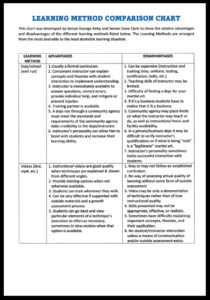
Learning Method Comparison Chart 9/22
This chart was developed by Sensei George Kirby and Sensei Dave Clark to show the relative advantages and disadvantages of the different learning methods. The Learning Methods [dojo, videos, books, live seminars, zoom seminars, friend,] are arranged from the most desirable to the least desirable learning situation.
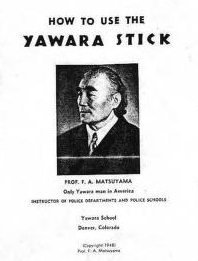
How to Use the Yawara Stick
This short book, published in 1948 by F.A. Matsuyama was recommended to me by Sensei Jerry Heines. If you’re interested in a copy click on the name of the book for this great historical resource. For a good history of the yawara stick [and also yawara in general] by Don Rearic click on this link: http://www.donrearic.com/yawara.html .
For Budoshin Jujitsu yawara/koshi-no-bo techniques click here to get the Budoshin Jujitsu 2013 Summer Camp mp4 videos. Techniques are in Part 1.
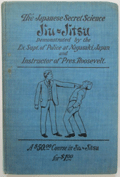
The Japanese Secret Science Jiu-Jitsu [published 1905] 2/17
I don’t know how long this link will be active but you need to download this great historical resource showing jujitsu techniques taught to President “Teddy” Roosevelt. Thanks to Robert Harland for making this resource available. Lots of “Budoshin Jujitsu” techniques! 🙂 Click on the title to download the link!

Downloadable Resources from JudoInfo.com
Andrew Zerling turned me onto this site as a great resource for downloading really old [and some current] martial arts resources [books, manuals, excerpts]. Just click HERE to go to their “Judo Books” page.
Three sources that I found to be very interesting were:
Fatal Blows & Kuatsu, by Kano -2005: click HERE
Hagakure, by Tsunetomo – 2005: click HERE
Principles of Jujutsu, by Kano – 2013: click HERE
United States Marine Corps Close Combat – 1999: click HERE
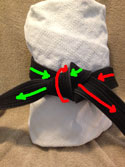
Tie Your Obi in 4 Easy Steps 10/14
Follow the arrows and directions on these 4 pix of how to tie your belt properly and be done in a snap. Yes, the belt knot points to your right!

Tie Your Gi Pants in 8 Simple Steps 7/16
Students come up with all sorts of inventive ways to tie their pants, many of which don’t keep their pants up. Here’s a simple 8-step process that’s simple enough for anyone to follow — and it works. My students really appreciate this pictoral instruction page. It save them from the potential of embarassment in class.

World War I & II Judo Training
This historical video, found on YouTube, discusses the Judo training in both world wars and the life of Captain Allan Smith, and the aspect of self defense drilling. The skills taught were referred to as judo rather than jujitsu as “judo” was the more commonly accepted term for judo self-defense [jujitsu] at the time. Thanks to Gary Witus for this historical reference.

Daitoryu Densho
Every traditional Japanese Jujitsu ryu has a densho, or scroll of the core techniques of the art. I was fortunate to receive this densho several years ago from an anonymous source. Usually the densho is handed down from the senior sensei to the most senior student who has already proved himself to be the future senior sensei of the ryu. Although the scroll is in kanji, someone added notes in English at some point, perhaps giving it a bit more or less value, dependent upon who you are.


